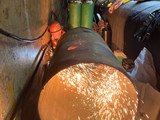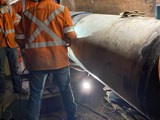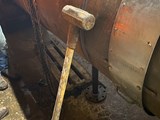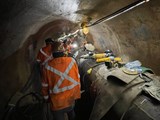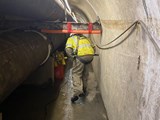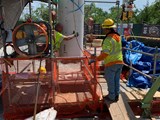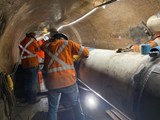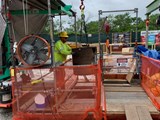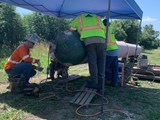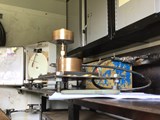Cut Out Inside of a Tunnel
When multiple utilities need to traverse rivers, channels, canals or harbors, tunnels are often employed to do the job. This makes it easier to construct and service the utilities. It is also easier to maintain. Over time damage in the form of corrosion can occur. Midwestern Contractors was selected to perform a cut out on a 30 inch, 0.375” WT high pressure, natural gas pipeline. The line was in a tunnel 80’ deep. The entire length of the tunnel was over 400’.
The vertical access tunnels on each end of the tunnel allowed for lowering men, tools ventilation equipment, and material into the tunnel.
Scope of Work
Smart tools revealed defects in the wall of a 450' section of pipe. The decision was made to cut out seven sections of pipe and weld in replacements. The replacement sections were pre-hydrostatically tested, and after welding, would be X-rayed and coated.
Safety Considerations
Ventilation consisted of multiple high-volume fans that moved air through the tunnel sufficient to support the crew and exhaust welding fumes. The number of workers in the tunnel was limited and all workers had to stay upwind, when welding operations were underway.
The 30” line was sampled for LEL’s, air movers were placed at the block valves at each end of the tunnel and a 4” air inlet hole was cut into the pipe, in the cut-out section. This allowed for complete evacuation of LEL’s from the high pressure pipe
The total number of people allowed in the tunnel at any given time was limited to 12. The total airflow required to accommodate people and welding machines equaled 6,400 CFM. The installed ventilation fans supplied over 8,000 CFM.
Standard PPE’s included hard hats, safety glasses, hearing protection, reflective vests, steel toe boots, and gloves.
Safework plans detailed every aspect of the project and were reviewed daily during the toolbox talks.
Other hazards included electrical, rigging, suspended loads, confined space, toxic and explosive atmospheres.
The pipe was magnetized, and this posed significant problems for the welders.
Workflow
- Install ventilation and work lighting
- Construct and entry point with rigging to lower and lift equipment, gas bottles, and material.
- Construct scaffolding to allow worker access with safe ladders and landings
- Support the pipe with wood cribbing, install floor anchors and secure the pipe on both sides of the cut-out
- Sample pipe for LEL’s
- Ventilate the pipe with a four-inch inlet hole and air movers
- Torch cut the damaged pipe section
- Move section to access shaft and hoist section out with a crane
- Hydrostatically test, then cut and bevel one end of the replacement section
- Lower replacement section into access shaft
- Allow replacement section to stabilize to the tunnel temperature
- Position, jack into place, clamp, and tack weld
- Complete welding utilizing two welders
- Repeat 7 times for all cut out sections
- Nondestructively test the welds with X-rays and coat
- Remove equipment, gas bottles, and clean-up the work area
- Remove scaffolding and topside equipment
Summary
Our project manager and field superintendents worked diligently to prepare for this project. This helped us to choreograph the work that was to be carried out in the confined space of the tunnel. With the help of our safety officers the Lock-Out-Tag-Out (LOTO), and all safety procedures were executed without incident. This small project was executed flawlessly because of planning and preparation on the front end. Midwestern Contractors approaches all projects with the same diligence. Our objective is to build confidence in our customers that we can perform safely and deliver a quality built project that will last.
About
Midwestern Contractors is a 70-year-old, employee owned, pipeline, station, and pipeline maintenance company. Our service area includes the upper tier of states from PA, NY, MD to the Dakotas and NE, and south to KY, TN, MO. Specialties include green and brownfield stations, interstate pipelines, relocations and laterals, maintenance and integrity work. For more information click on Contact or Request a Project.

